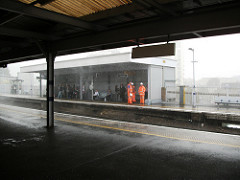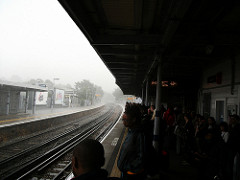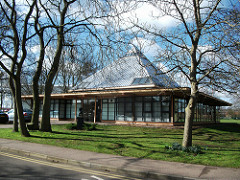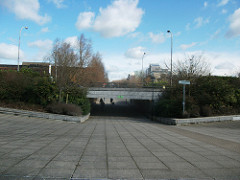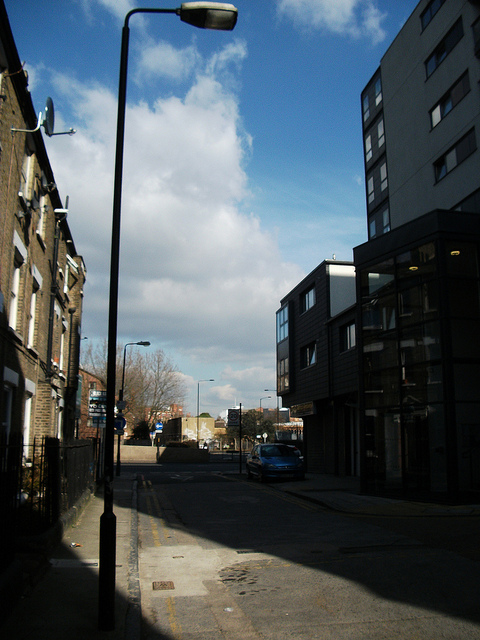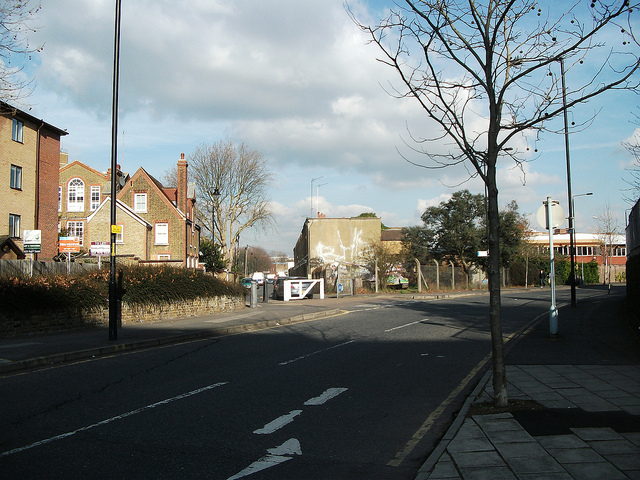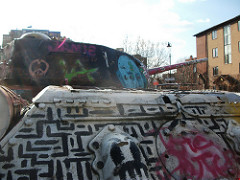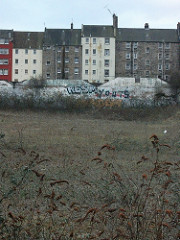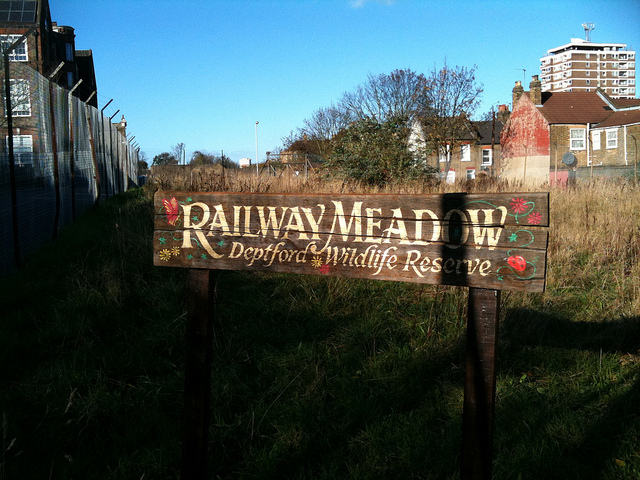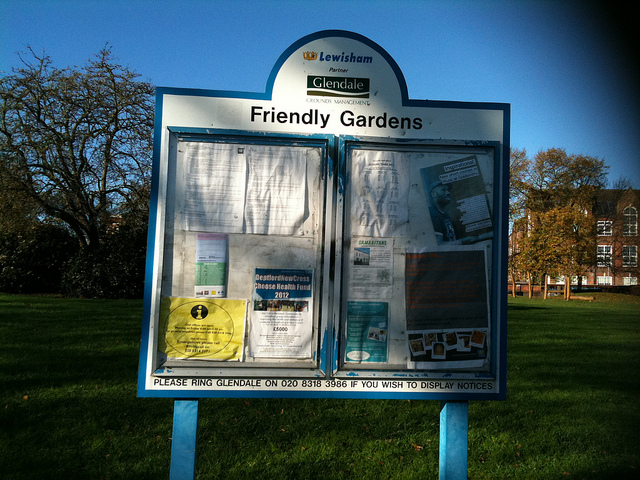It is a thing little remembered – even by the Wise – that Dwarven miners had been laying or carving tracks along the floor of their tunnels to ease the movement of ore trucks and other gear since at least the end of the Second Age. Moria, in its time of glory, was completely spanned by such, and a cable-hauled gravity-assisted rack-and-pinion railway was laid in the to take mithril and gems down to Lorien, and return with such provisions as even Dwarves need.
After the fall of Moria the Orcs of the Misty Mountains copied the Dwarves in this, as in so many other things. Bilbo never knew it, but had he fled from Gollum only a few minutes earlier would have run into a band of Orcs using a pit pony to haul mine waste from the new diggings towards the eastern entrance.
Such labour-saving machines never spread from the free Orcs of the Northern Mountains to their Master in the South, Sauron – despite the slanders of some Elves and Men – was never a lover of mechanism for its own sake. And he had many slaves and did not see why he should ease their burdens by providing wheeled vehicles.His mines and armouries were worked by muscle and the whip.
Saruman however was obsessed with efficiency and progress. In the ruins of Isengard, near the base of Orthanc, the men of Rohan came across a detailed scale model of the Ring of Isengard as it might become after victory, and rails ran everywhere, complete with little working steam engines, stations with tiny model Orcs waiting on the platforms – some with tinier Orc babies, it was never true that Orcs were born from vats though some of the larger ones may have been grown in them – and troop trains full of Uruk-Hai in complex and colourful uniforms correct in every detail, The Horse-Lords could make nothing of this, thinking it some complex charm, and the layout was not understood for what it was till it fell into the hands of one of Peregrine Took’s grandsons almost a century later.
The first public railways of the Fourth Age were due to the ingenuity – and eye for profit – of the Men of Dale. The Dwarves of the Iron Hills were using rails to haul waste our of their mineworkings, as they had done for cenbturies. Bard IV of Esgaroth saw this while on a trade delegation and realised at once that a similar but larger pony-drawn system could be used to take iron or ore or manufactured goods to the Lonely Mountain and the Long Lake much more cheaply than the pack mules and handcarts used in the past. That would now only save money, it would lock the Dwarves into trade through Dale, with everything passing through the Lake and then down the Running River
Very sensibly – the Bardlings were nothing but sensible and cautious in matters of commerce – the Dalemen started with some experimental track along the sides of the river and up to the Mountain. With their experience of boatbuilding and toymaking and their love of ingenious tricks, they soon laid a few miles of wooden track and started running loads up and down. They soon found that they were making almost as much money from children paying pennies for the ride as they were from the few goods passing to and from the Dwarves of the Mountain, and embarked on their great project in the twelfth year of the Fourth Age.
Its hard to say whether the Old Iron Hills Railway was a success or not. The wooden rails, so simple to make and lay in the vicinity of Laketown, were a great burden to keep in repair on so large a scale. Wood had to be cut and shaped up to two years before then seasoned and bent into shape. Stocks of wood had to be kept at stages along the way and men had to be ready to repair any damage within a day. The output of the Dwarf mines was never quite large enough to pay for all this, and the Permanent Way often lay damaged and useless for weeks at a time, especially in winter.
On the other hand, and unlooked-for, the railway led to the growth of a new kingdom in the North. Ever since the death of the Dragon, men had been moving into the empty lands north and east of Mirkwood. Some flying from the horror in the South, others merely looking for wider room for their growing families. After the end of the War of the Ring, when Wilderland knew peace and security for the first time in over three hundred years, thousands of poor and landless flocked up the Running River from Rhovanion, to plant corn and children in the wide plains between the Mountains and the Wood. And as Men do they began to build hamlets and villages and to hold markets and fairs. At first these fairs were by the River, for all trade and travel was by the River. But as soon as the Railway was laid, and the staging posts and wood stores and horse-stables built, strangers began to gather around them. The Men of Dale were like to send them away but Bard, canny for coin, welcomed them in so long as they swore to obey the laws of the land, and offered them the use of the Way to carry their goods and their gear – for a price. Even when the Railway failed these new towns lived on. And so, three dozen years after it was builded, the Old Iron Hills Railway no longer just joined the Dwarves of the Mountain with those of the Hills over a hundred miles of wilderness, it ran through a fertile land of Men, stout farmers, eager and willing to trade their wheat and barley and beer and cider and leather and mutton for the trinkets and toys of the Dalemen and the Dwarves.
The next chapter in the Railway History of Middle-Earth is written far to the West, in the Shire. It is true, that on hearing of the Railway in Dale King Aragorn had a stone track built or carved to connect Minas Tirith, Osgiliath, and Minas Ithil, but it was never much more than a curiosity. However, on one of his many visits to the City in which he had served the Steward so faithfully in the War of the Ring, and about fifty years after the end of that War, Peregrin Took of the Shire happened to meet with Fror, the grandson of that Fror whose brothers Thror and Gror founded the Kingdoms of the Mountain and the Iron Hills, who was in Minas Tirith with some of his folk to restore parts of the Second Level of the City still bearing damage from the siege. There Fror told of the Iron Hills Railway among many other marvels of Dwarf-work at Dale and the Mountain, and the Took formed a desire to see this thing.
He never did of course – he remained in the Shire for the next ten years before returning to Gondor in retirement – but his son Faramir, Thain after him, and more especially *his* son Samwise II – later Thain and Shire-Reeve, but at this time still a boy with a boy’s enthusiasms – took up the idea, and made a garden railway on their own land between the Great Smials and Tuckborough. But this railway was made with iron rails – somehow Faramir had had carried to the Shire much of the metal left over from the ruin of Isengard, and some of the forges set up by Saruman in his brief period of rule were still in operation remaking it into whatever the Hobbits needed. And for three years not a birthday or a festival went by without the children of Tuckborough being treated to a ride up and down the garden and round the corner to the pond, drawn on iron rails by small, friendly, ponies.
However conservative they may be in other ways Hobbits are never slow to take up new ideas that both save work and please children, and this garden railway was all the rage. Three or four smaller ones were set up around the Shire in the next couple of years, but no truly working railway was built until the South Farthing Iron Road of FA54 which connected the farms and market at Longbottom with the Shirebourn so that produce could be exported down the Brandywine,
Then came one of those coincidences which make one wonder if history is indeed made by men and elves, or if there is some over-riding Story or Plot behind it all. Ever since the fall of old Cardolan, the lands immediately to the south and east of the Shire had been inhabited by a mixed bag of Men, Hobbits, and Orcs, living from hand to mouth in small isolated communities and in fear of each other as well as both the Orcs of the Mountains and the Elves of Rivendell. Its only surviving settlements of any size were Buckland, which was effectively an addition to the Shire, the villages of the Breeland, and the small hamlet at Sarn Ford. As is well known the land of Cardolan fell under the fear and spell of Saruman during the War of the Ring, and its greenways and rivers were used by him to trade secretly with the Shire and the Dwarves. At the end of that War Saruman’s rabble briefly tried to take over the Shire, but were expelled by the Ringbearer and his companions. Expelled, but not destroyed. They were forced to take to the hills. But now there was a King in Gondor, and trade and fair folk passed up and down the Greenway and the Brandywine. So the rabble and the heathmen followed the trades they had learned from Saruman, as carters and cobblers and bargees and ferrymen, and it was into their hands that that the Hobbits of the South Farthing placed their pipeweed and their broadcloth and their other produce, and from their hands that they received in return gold and goods in great store fromn the South.
And it was one of them who came to the Thain one night with a proposal for a new kind of railway. An ugly man, past the best of his youth, almost toothless with long arms and calloused hands, he had the look of a half-orc. It is said he was named Bill Ferny but we need pay no heed to such stories – all the heath-men and river-wanderers were called “Bill Ferny” in those days, for “Ferny” means nothing more than a man of the fens or the moors, and “Bill” is what the Hobbits would call any stranger without a name. This Bill Ferny’s father had been in Isengard in the War, and had – he said – there learned the secret of cunning engines which could drive a hammer or a wheel without need for horse or man to turn and pull. All that was needed was wood and water – or the black rock that burns that the Dwarves mine in the Ered Luin – and with such engines a new kind of railway could be built. But (there is always a but) the only folk who knew how to make such things were some of those who had been in Isengard before the war. And they were such as were not popular in the Shire, and avoided sunlight.
The deal was done. Peregrin Took was safely in Gondor, and in FA 56 Bill Ferny – or whatever his name was – and some rather strange friends of his moved into Tookbank and, working mostly at night or underground, constructed the first steam locomotives ever seen in Middle Earth. At the same time the Hobbits of the West Farthing extended the old garden railway from Tuckborough to Michel Delving. In September FA 61 – by coincidence the 80th anniversary of Bilbo’s eleventyfirst birthday – the Tuckborough and Michel Delving Railway had its Grand Opening. Everyone was there for miles around. Stout old Hobbits and little Hobbit children queued up for hours to take the five mile ride. And so the railway madness began.
Within another three years the Hobbiton, Bywater and Frogmorton was running east-west alonmg the Old East Road. Desperate to beat them to make a connection with Buckland the Tooks allied themselves with Hobbits of the Marish to lay the Green Hills Railway east towards Stock, just as the South Farthing Iron Road converted to steam and laid a new branch at great expense across the marshes to Deephallow. Not wishing to be left out, other Hobbits laid the Greenfields, Scarry, and Bridgeford in the North Farthing – with a branch to Long Cleeve, and the Sackville-Bagginses amoing others made a north-south line connecting Sackville with Michel Delving and Little Delving then curling east to Nobottle. Another, shorter, line the most profitable of all, the Hobbiton and Central Shire funded by the Proudfoots and Hardbottles, joined Bywater to the Tooklands.
This had a deep effect on the society and economy of the Shire and beyond. The new railways soon outgrew the iron scavenged from Isengard and were in the market for new Dwarf-forged metal. Some came from Ered Luin, and before long iron to make tracks and coal to fire engines was itself being brought in by rail – by the end of 64 the Hobbiton, Bywater and Frogmorton had extended west to Michel Delving from where, despite fiece competition within the Shire, the two co-operated on the Grand United Western Railroad across the Far Downs and Tower Hills to the Havens. The move west was also under the protection and direction of Elanor Gamgee Fairbairn, whose late husband Fastred had been appointed Warden of Westmarch by King Elassar in FA 41, and so became the first official of the Kingdom of Arnor to rule over any of the coastlands for over a thousand years, and who was still trying to establish her authority.
But the requirement for iron and steel seemed never-ending. Single-track railways were upgraded to two or four tracks, narrower tracks to Great Smials Standard Gauge (based on Peregrin Took’s greatest rumoured height, said soon after to have been four-foot eight-inches, though there is no record from his lifetime of either him or Meriadoc Brandybuck exceeding four-foot-six), ever-smaller settlements were connected to the system, so more steel had to come from the Iron Hills. This was taken by horse-drawn rail to the Long Lake then *up* the Forest River almost to Mount Gundabad, then, at first, down the Anduin all the way to the sea and by coastal ship to the Brandywine and up-river by barge to be unloaded at the rapidly-growing docks at Bucklebury. Other ships went all the way to the Havens of Lindon to meet the railway there. The Iron Hills Railroad was itself upgraded to use iron rails and steam haulage – with locomotive parts brought back from the Shire by sea and river. But as dwarves re-established themselves in the most ancient of all their delvings at Gundabad, increasingly the metal was transported overland to the Shire across an ever-decreasing gap as the North Downs Railway was built west and south of Gundabad towards Fornost, and the Buckland and King’s Norbury which was at forst built eastwards to meet it from the great bend of the Brandywine as it comes out of Lake Evendim, but then joined to the eastern bounds of the Shire. The old town of Fornost, re-founded by Aragorn Elessar in the early years of the Fourth Age as a garrison to protect the Shire and eastern Cardolan from the many wild things that still sulked around or beyond Carn Dum, once again prospered.
But these were small things compared with the changes in the life and ways of the Shire itself. Hobbits are hardy folk, but neither size nor temperament suits them to the life of an Inland Navigator. From the begining they employed others to dig cuttings, bank earth, and lay track. And those others lived in and around the Shire in their own camps and townships, with wages to spend and bellies to fill. So there was a second incoming of Big Men to the Shire – though mostly women this time – catering to the wants of the navvies, whether human or half-Orc. It would be an exaggeration to say that the streets of Michel Delving or Buckleberry were no longer safe for a hobbit-lass to walk on a Friday night, but things were certainly lively, and noisier, than they had been. This was all in spite of the Royal Edict of FA 6 expressly forbidding Big Men to enter the Shire.
Also, although – like the men of Dale – Hobbits were keen-eyed, nimble-fingered, and well-learned in machineries such as millcraft and clockwork, they had none among them skilled in forging large iron structures, nor the boilers and other pressure vessels needed for steam engines. The masters of that craft were found only among the scatterlings of Isengard, where they had learned from Saruman himself. And many, maybe most of them, were Orcs. And so, for the first time anywhere in Middle Earth, small numbers of Orcish folk lived among Men (for the Hobbits in truth were naught but the smallest kind of Men) not as slaves or warriors or prisoners but as workers, and well-paid well-skilled workers at that.
There were few direct intimate liaisons between Uruk-Hai and Hobbits (if only for obvious reasons of scale) but that did nothing to stop a rather unpleasant campaign of printed posters saying “Would you want one to marry your sister?”. There were, however, a large contingent of half-orcs and orc-like Men and, as said above, large numbers of women of various sorts providing for them. So slowly, over a few generations, fpor the first time in Middle-Earth, Big Men and Halflings and Orcs merged into one mixed people, brought together by the Railway. And by the middle of the Fourth Age the Shire Folk, no longer as small and slight as their forefathers before the War of the Ring, had come to rule over much of Eriador and Arnor and the coastlands. Many of the Wise think this to be the origins of our modern European populations – our long arms and stout legs compared with other humans, our pale, clammy, skin, or vestigal brow-ridges – these were not the features of the ancient Men of Numenor.
But we are getting ahead of ourselves. None of this was in sight in FA 70 when, in the year of Peregrin Took’s death, Matt Brockhouse and Ham Clayhanger, signalmen of the Overhill, Brockhouse and Bree Railway (despite the name the extension to Bree was still a distant dream – no road has ever been cut through the Old Forest for some reason, and Bree was not connected until the line coming north out of Sarn Ford paralell to the Great North Road was completed in 92, the first major section of what was to become the Gondor and Arnor Railway, the greatest engineering feat of the Age) began their experiments with block signalling in response to the Stockbridge Disaster of the year before…

